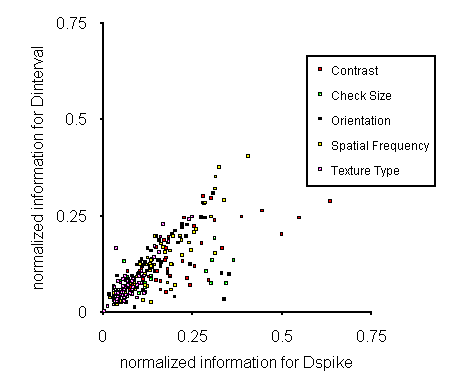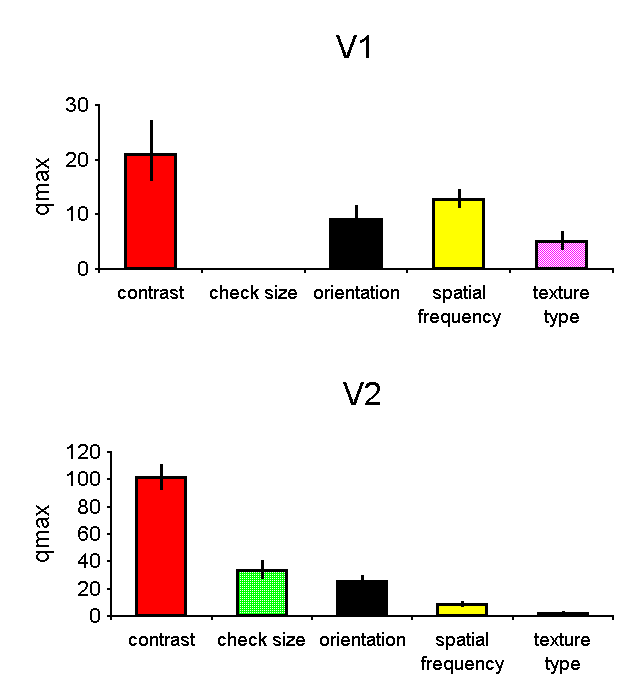
We recorded single-unit and multi-unit activity in response to transient presentation of texture and grating patterns at 25 sites within the parafoveal representation of V1, V2, and V3 of two awake monkeys trained to perform a fixation task. In grating experiments, stimuli varied in orientation, spatial frequency, or both. In texture experiments, stimuli varied in contrast, check size, texture type, or pairs of these attributes.
In order to examine the nature and precision of temporal coding, we compared individual responses elicited by each set of stimuli in terms of two families of metrics. One family of metrics, Dspike, was sensitive to the absolute spike time (following stimulus onset). The second family of metrics, Dinterval, was sensitive to the pattern of interspike intervals. In each family, the metrics depend on a parameter q , which expresses the precision of temporal coding. For q = 0, both metrics collapse into the "spike count" metric (Dcount), which is sensitive to the number of impulses but insensitive to their position in time.
Each of these metrics, with values of q ranging from 0 to 512/sec, was used to calculate the distance between all pairs of spike trains within each dataset. The extent of stimulus- specific clustering manifest in these pairwise distances was quantified by an information measure. Chance clustering was estimated by applying the same procedure to synthetic datasets in which responses were randomly assigned to the input stimuli.
170 of the 352 datasets showed evidence of tuning via the spike count (q = 0) metric. 294 of the 352 datasets showed evidence of tuning via the spike time metric and 272 of the 352 datasets showed evidence of tuning via the spike interval metric to the stimulus attribute (contrast, check size, orientation, spatial frequency, or texture type) under study. Across the entire dataset, the information not attributable to chance clustering averaged 0.042 bits for the spike count metric, 0.171 bits for the optimal spike time metric, and 0.107 bits for the optimal spike interval metric.
The reciprocal of the optimal cost q serves as a measure of the temporal precision of temporal coding. In V1 and V2, with both metrics, temporal precision was highest for contrast (ca. 10 - 30 msec), and lowest for texture type (ca. 100 msec). This systematic dependence of q on stimulus attribute provides a possible mechanism for the simultaneous representation of multiple stimulus attributes in one spike train.
Our findings are inconsistent with Poisson models of spike trains. Synthetic datasets in which firing rate was governed by a time-dependent Poisson process matched to the observed post-stimulus time histogram (PSTH) overestimated clustering induced by Dcount and, for low values of q, Dspike[q] and Dinterval[q]. Synthetic datasets constructed from a modified Poisson process which preserved not only the PSTH but also spike count statistics accounted for the clustering induced by Dcount, but underestimated the clustering induced by Dspike[q] and Dinterval[q].
This scattergram shows that in nearly all recordings, there is
a greater degree of stimulus-dependent clustering for a metric
based on absolute spike times than for a meetric based on
interspike intervals.

This summarizes how the precision of temporal coding depends
on the stimulus attribute. qmax indicates the value of q which
leads to maximal clustering in the spike time metric; 1/qmax can
be thought of as the maximum time that a spike can be moved
before it is no longer seen as "similar". In both V1 and V2,
contrast is coded with greatest precision, and
texture type is coded with less
precision. The difference is greater in V2 than in V1.
